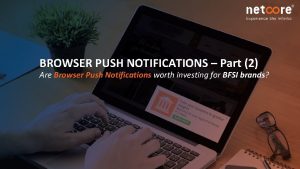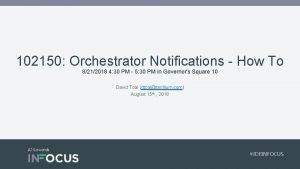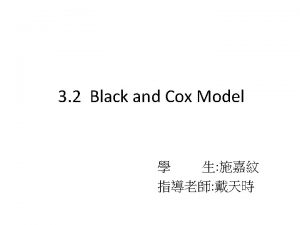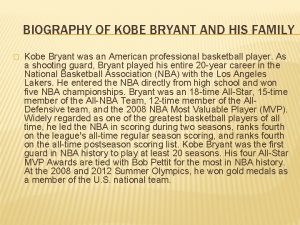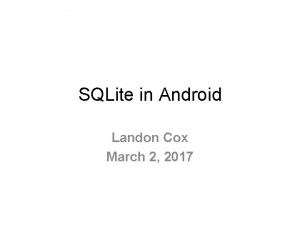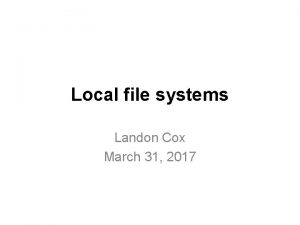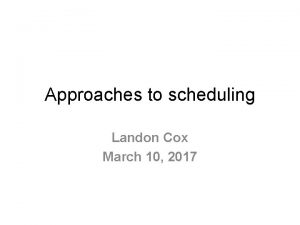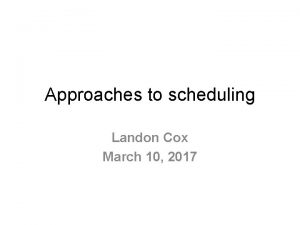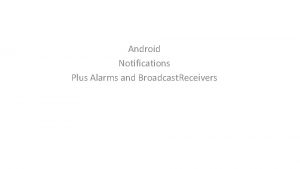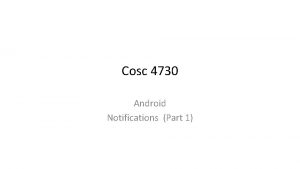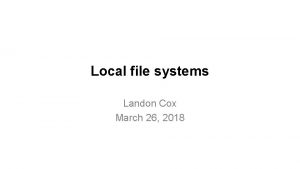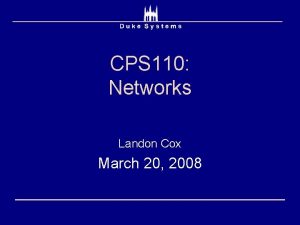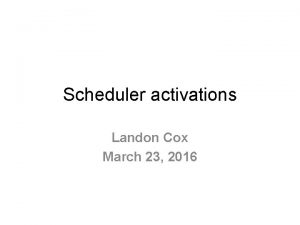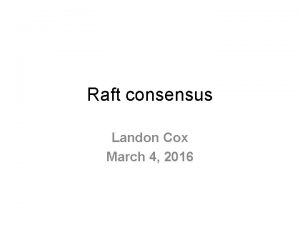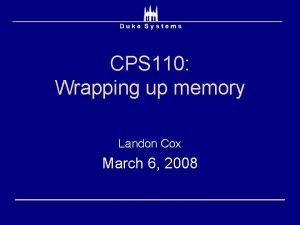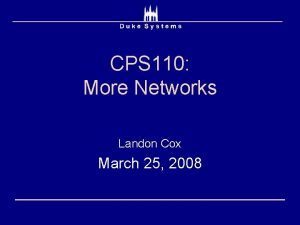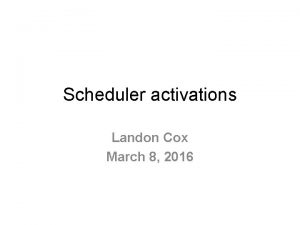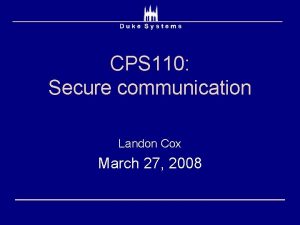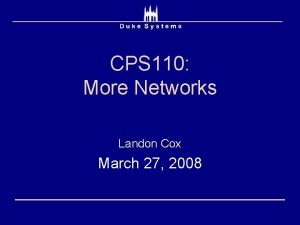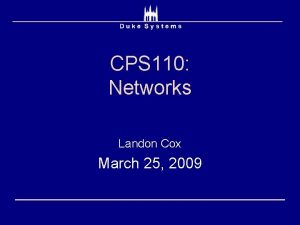Notifications and Services Landon Cox March 28 2017



























- Slides: 27

Notifications and Services Landon Cox March 28, 2017

Networking so far • Volley (retrieve quiz stored at URL) • User starts app • Check with server for new quiz • Say you’re building a messaging app … • How else might you use the network? • Are the workflows different than those we’ve seen?

How do we keep device data fresh?

Solution 1: polling • Basic idea • App periodically sends message to server • Asks, “is there anything new for me? ” • Very simple to implement • Create a timer • When timer fires, exchange messages with server • What’s the problem?

Impact of polling on battery • Network power • • • Assume radio stays in high-power state for 10 sec. • • • Energy per LTE poll: 1500 m. W x 10 seconds = 15 Joules 5 min frequency: 480 J/day 30 sec. frequency: 4800 J/day Total Pixel battery: ~40 k Joules You probably have more than one app that needs to sync • • LTE: 600 – 1700 m. W Wi. Fi: 77 – 130 m. W If you have a lot of apps, your radios will always be in a high-power state Choosing the right period right is difficult • • Check too often and drain the battery with useless messages Check too infrequently and user experience will suffer http: //dl. acm. org/citation. cfm? id=2307658

Every outgoing query will put the radio in a high-power state.

Solution 2: push notifications • Share persistent network connection across apps • • • Device and server maintain (TCP) connection Radio can enter low-power state when no updates Server pushes updates to device Device can push updates to server Updates should be small (< 4 KB) • On-device service routes updates to apps • Example: Firebase Cloud Messaging (FCM)

Share one persistent connection. High-power only when data is ready.

Firebase cloud messaging (FCM) • Formerly Google Cloud Messaging (GCM) • On your device • Google Play Services (global, maintains connection to cloud) • Firebase. Instance. IDService (per app, receives instance ID) • Firebase. Message. Service (per app, receives notifications) • In the cloud • Firebase (routes messages to app server, devices) • App server (stores data, manages messaging)

Firebase cloud messaging (FCM) • Formerly Google Cloud Messaging (GCM) • On your device • Google Play Services (global, maintains connection to cloud) • Firebase. Instance. IDService (per app, receives instance ID) • Firebase. Message. Service (per app, receives data) • In the cloud • Firebase (routes messages to app server, devices) • App server (stores data, manages messaging) Next time

Services • Service • Performs tasks on main thread: on. Start. Command • Defined as an app component • Because it is a component, it is externally visible • Who schedules most work on threads? • Code already running inside our app

Services • Service • Performs tasks on main thread: on. Start. Command • Defined as an app component • Because it is a component, it is externally visible • Why might external visibility be useful? • Allows processes to communicate with each other

Services • Service • Performs tasks on main thread: on. Start. Command • Defined as an app component • Because it is a component, it is externally visible • Why are services essential for FCM? • Gives Google Play Services a place to send messages • Forward new data from Firebase to app’s Service

Services • Service • Performs tasks on main thread: on. Start. Command • Defined as an app component • Because it is a component, it is externally visible • Need to add Service to Android Manifest Android. Manifest. xml: <application … <service android: name=“. My. Service” /> />

Services • Example Service • Create a subclass of Service • Use a worker thread to process IPC requests • Handle requests serially public class My. Service extends Service { protected int on. Start. Command(Intent intent) { // process IPC request } What } thread does this run on?

Services • Example Service • Create a subclass of Service • Use a worker thread to process IPC requests • Handle requests serially public class My. Service extends Service { protected int on. Start. Command(Intent intent) { // process IPC request } } What is an Intent?

Quick Intents review

Displaying a web URL How does Android know which components could receive this Intent? Intent browser. Intent = new Intent(Intent. ACTION_VIEW, Uri. parse(" http: //www. google. com/images? q=duke ")); start. Activity(browser. Intent);

Intent filters Restricts which actions the Activity will accept (Intent Action must match) <activity android: name=". Main. Activity"> <intent-filter> <action android: name="android. intent. action. MAIN" /> <category android: name="android. intent. category. LAUNCHER" /> </intent-filter> </activity>

Intent filters <activity android: name=". Main. Activity"> <intent-filter> <action android: name="android. intent. action. MAIN" /> <category android: name="android. intent. category. LAUNCHER" /> </intent-filter> </activity> Describes categories of Intent Activity accepts (Intent categories must match all)

Implementing My. Service • We can do this! • Tools to use • Handler • Looper • Handler. Thread • Useful to peak under the FCM hood

Implementing My. Service public class My. Service extends Service { private Looper m. Looper; private Service. Handler m. Handler; protected void on. Create() { // on which thread does this code run? } protected int on. Start. Command(Intent intent) { // on which thread does this code run? } private class Service. Handler extends Handler { public Service. Handler(Looper l) { super (l); } public void handle. Message(Message m) { … } } } https: //developer. android. com/reference/android/app/Service. html What needs to happen?

Implementing My. Service public class My. Service extends Service { private Looper m. Looper; private Service. Handler m. Handler; protected void on. Create() { Handler. Thread thread = new Handler. Thread(…); thread. start(); // Get the Looper and use it for our Handler m. Service. Looper = thread. get. Looper(); m. Service. Handler = new Service. Handler(m. Service. Looper); // on which thread does this code run? } … private class Service. Handler extends Handler { public Service. Handler(Looper l) { super (l); } public void handle. Message(Message m) { … } } }

Implementing My. Service public class My. Service extends Service { private Looper m. Looper; private Service. Handler m. Handler; protected void on. Create() { // on which thread does this code run? } protected int on. Start. Command(Intent intent) { // on which thread does this code run? } private class Service. Handler extends Handler { public Service. Handler(Looper l) { super (l); } public void handle. Message(Message m) { … } } } What needs to happen?

Implementing My. Service public class My. Service extends Service { private Looper m. Looper; private Service. Handler m. Handler; … protected int on. Start. Command(Intent intent) { Toast. make. Text(…). show(); // For each start request, forward the Intent Message msg = m. Service. Handler. obtain. Message(); msg. arg 1 = intent; m. Service. Handler. send. Message(msg); return 0; // on which thread does this code run? } … }

Implementing My. Service public class My. Service extends Service { private Looper m. Looper; private Service. Handler m. Handler; Lucky for you, you can just subclass Firebase Services! protected void on. Create() { // on which thread does this code run? } protected int on. Start. Command(Intent intent) { // on which thread does this code run? } private class Service. Handler extends Handler { public Service. Handler(Looper l) { super (l); } public void handle. Message(Message m) { … } } }

Firebase services • Firebase. Instance. IDService • Why does each app instance need a unique ID? • Who manages mapping from users to instance IDs? • Firebase. Message. Service • What should happen if your app is in the foreground? • What should happen if your app is in the background? • Note: you will likely need to update via SDK manager git clone https: //github. com/firebase/quickstart-android. git
 Anthem of poland
Anthem of poland Process book pi
Process book pi Sendspace notifications
Sendspace notifications Netcore smartech browser push notification
Netcore smartech browser push notification Notifications
Notifications Push notification app inventor
Push notification app inventor November short form
November short form Cqc notifications safeguarding
Cqc notifications safeguarding Jde orchestration resources
Jde orchestration resources Cathy landon
Cathy landon Child, youth and family services act, 2017
Child, youth and family services act, 2017 Black and cox model
Black and cox model Sylica
Sylica Nelson and cox
Nelson and cox Nelson and cox
Nelson and cox Inhibidores selectivos de la cox-2
Inhibidores selectivos de la cox-2 Alccs
Alccs Ingemar j. cox
Ingemar j. cox Cox regression
Cox regression Rumack-matthew nomogram
Rumack-matthew nomogram Coxweb
Coxweb Alicia cox x
Alicia cox x Raymond cox qc
Raymond cox qc Jessica cox biografia
Jessica cox biografia Cox
Cox Kansas soil map
Kansas soil map Boxplot minitab
Boxplot minitab Kobe bryant family life
Kobe bryant family life



